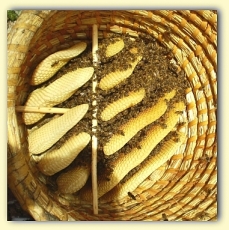 |
NOVE POTI V ČEBELARSTVU
Iskanja ne-kemičnih pristopov v čebelarjenju; FORUM ZA ZBIRANJE KVALITETNIH INFORMACIJ O POTEH K ZDRAVI ČEBELI
|
| Poglej prejšnjo temo :: Poglej naslednjo temo |
| Avtor |
Sporočilo |
majql
Pridružen/-a: 01.09. 2012, 22:32
Prispevkov: 54
|
 Objavljeno: 17 Jan 2013 08:51 Naslov sporočila: antibakterijske lastnosti slovenskih medov Objavljeno: 17 Jan 2013 08:51 Naslov sporočila: antibakterijske lastnosti slovenskih medov |
 |
|
Nekaj malega o dobrem slovenskem medu v tuji literaturi.
lp, miha
Wednesday, January 16, 2013
Antibacterial Effect of Slovenian Honeys Mostly Due to Peroxide Action
Antibacterial and Antimycotic Activities of Slovenian Honeys
Br J Biomed Sci, 2012;69(4):154-8
In the present study, Slovenian honey samples produced from different floral sources are evaluated for their antibacterial and antifungal properties. The peroxide contribution to antibacterial activity is also determined.
Minimum inhibitory concentration (MIC) of the honeys was assessed against four bacterial species (Escherichia coli, Enterococcus faecalis, Pseudomonas aeruginosa and Staphylococcus aureus) and against eight fungal species (Aspergillus niger, Aureobasidium pullulans, Candida albicans, Candida parapsilosis, Candida tropicalis, Cladosporium cladosporioides, Penicillium chrysogenum and Rhodotorula mucilaginosa).
Honey at concentrations between 1% and 50% (v/v) were tested. Although all of the bacterial species were inhibited by the different honey samples, the chestnut and pasture honeys showed the highest antibacterial activities. The antifungal activities were concentration-dependent, with five (Aureobasidium pullulans, Candida parapsilosis, Candida tropicalis, Cladosporium cladosporioides, Rhodotorula mucilaginosa) inhibited only at honey concentrations greater than 50%. The fungi Aspergillus niger, Candida albicans and Penicillium chrysogenum were not inhibited by any of the tested honeys, even at the highest concentrations. The lowest MICs seen were 2.5% (v/v) for the chestnut, fir and forest honeys against Staphylococcus aureus, and 10.0% (v/v) for the chestnut and pasture honeys against Cladosporium cladosporioides.
The non-peroxide action of chestnut honey was tested against Escherichia coli. The MIC of the catalase-treated chestnut honey was 50% (v/v). The antibacterial effect of Slovenian honeys is mostly due to peroxide action.
These data support the concept that Slovenian honeys are effective antibacterials and antifungals, and can thus be applied for medicinal purposes.
(http://apitherapy.blogspot.com/2013/01/antibacterial-effect-of-slovenian.html?utm_source=feedburner&utm_medium=email&utm_campaign=Feed%3A+ApitherapyNews+%28Apitherapy+News%29)
_________________
dobra volja je najbolja! |
|
| Nazaj na vrh |
|
 |
|
|
Ne, ne moreš dodajati novih tem v tem forumu
Ne, ne moreš odgovarjati na teme v tem forumu
Ne, ne moreš urejati svojih prispevkov v tem forumu
Ne, ne moreš brisati svojih prispevkov v tem forumu
Ne ne moreš glasovati v anketi v tem forumu
|
|


